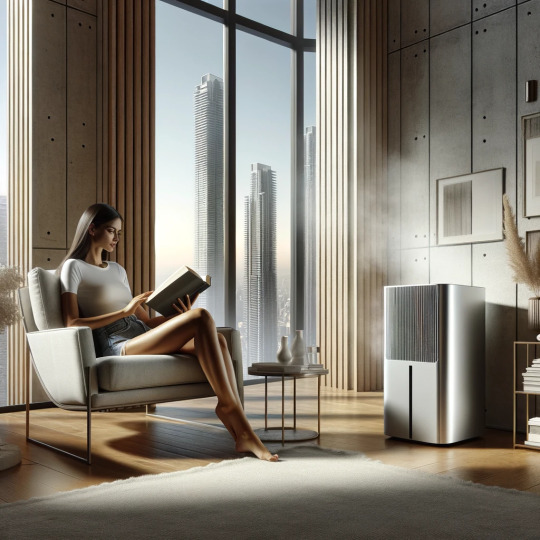#DehumidifyingTechnology
Text
Does a Dehumidifier Cool a Room? Exploring the Facts and Efficiency

A dehumidifier is a useful appliance that helps maintain a comfortable indoor environment by reducing the moisture level in the air.
Often, people wonder if using a dehumidifier can cool a room in addition to managing humidity. This question is especially relevant when maintaining a cool and pleasant living space, essential during hot and humid months.
To understand the role of a dehumidifier in cooling a room, it's important to consider how temperature and humidity levels impact our comfort. When the air contains high humidity levels, it can feel hotter than it is. By lowering the humidity, a dehumidifier can make the room feel more comfortable without necessarily reducing the temperature.
While dehumidifiers can create a more comfortable atmosphere by removing excess moisture from the air, their primary function is not to cool a room. Rather, they work as efficient humidity controllers, making them valuable indoor air quality and comfort tools.
Understanding Dehumidifiers and Room Temperature
How Dehumidifiers Work
Dehumidifiers remove moisture from the air, making a room feel more comfortable. There are two main types: desiccant dehumidifiers and refrigerant dehumidifiers.
Desiccant dehumidifiers use materials like silica gel to absorb moisture, while refrigerant dehumidifiers cool the air so the moisture condenses and is collected in a water reservoir.
Both types help reduce the humidity level in a room. However, they don't directly cool the room's temperature.
Dehumidifiers vs. Air Conditioners
Dehumidifiers and air conditioners both impact the air quality and comfort of a room, but they work in different ways:
Dehumidifiers remove moisture from the air, making it less humid.
Air conditioners cool the air temperature by removing heat.
Though dehumidifiers may make a room feel cooler because dry air helps sweat evaporate more easily, they don't actively cool the room. On the other hand, air conditioners are designed to cool a room's temperature directly.
Impact on Comfort and Health
When the humidity level in a room is high, it can be harder for your body to cool off through sweating. Dehumidifiers can help you feel more comfortable by removing moisture from the air. They can also have several health benefits:
Improved air quality: Lower humidity levels make it harder for mold and mildew to grow, which can help those with allergies or respiratory discomfort.
Less condensation: Reducing the amount of moisture in the air can help prevent condensation on walls and windows.
Fewer pests: High humidity can attract pests like dust mites and cockroaches, so keeping the moisture in check can create a cleaner living environment.
However, dehumidifiers do not replace the need for air conditioning if you require a cooler room during hot weather. It's often best to use a dehumidifier and an air conditioner to create a comfortable environment, as they work together to control temperature and humidity effectively.
Optimizing Room Environment with Dehumidifiers
Effective Placement and Usage
To maximize the performance of a dehumidifier in cooling a room, proper placement is crucial. Place the unit near areas with high humidity, like basements or bathrooms. Keep it at least 6 inches away from walls and furniture for optimal airflow. Also, ensure doors and windows are closed for better efficiency.
Monitoring and Maintaining Humidity Levels
A homeowner can maintain a comfortable environment by monitoring humidity levels. It's important to check the indoor air quality regularly. A hygrometer helps measure the relative humidity in a room. Aim for ideal humidity levels between 40% and 60% to create a comfortable atmosphere and prevent mold growth.
Consider using an advanced dehumidifier like the Midea 50-pint EnergyStar Smart Dehumidifier, which lets you easily control humidity levels, ensuring the room remains comfortable.
Managing Energy and Cost Efficiency
Dehumidifiers can be cost-effective in lowering energy bills if used properly. Here are some tips to maximize efficiency and save on energy costs:
Choose the right dehumidifier: Before purchasing, consider factors like room size, humidity level, and energy consumption.
Ventilate: Proper ventilation helps reduce humidity, so use exhaust fans when cooking or showering.
Set the correct humidity: Overuse can be costly, so keep the humidity setting within the recommended range.
Regular maintenance: Clean the air filter, empty the water tank, and check for any issues to keep the unit working efficiently.
By following these tips, a homeowner can achieve a comfortable and cost-effective living space with the help of a dehumidifier.
#DehumidifierTips#IndoorComfort#HomeHumidityControl#AirQualityMatters#HealthyHomeLiving#DehumidifyingTechnology#ClimateControl#MoistureManagement#EfficientHome#CoolingSolutions#HomeHealth#EnergyEfficientLiving#HumiditySolutions#SmartHomeTips#LivingSpaceWellness
0 notes